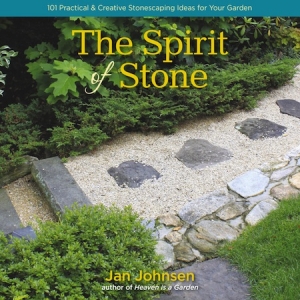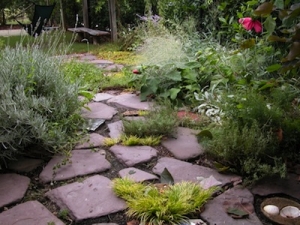Stones: An Everlasting Part of the Landscape
By George Graine, Fairfax Master Gardener
 Gardens are the result of a collaboration between art and nature. — Penelope Hobhouse
Gardens are the result of a collaboration between art and nature. — Penelope Hobhouse
If you have given any thought to the new, in-vogue no-mow yard, what has been your choice to replace that green swath called lawn? The design possibilities are many. It could be a combination of ground covers, dwarf conifers, flowering shrubs and ornamental trees. Any of these changes will come with its own set of problems and will require some degree of nurturing. Is there something else you could do to limit the continuing expense and maintenance and minimize problems with plant diseases and insects? YES! A creative and practical solution: use stones. Stone is durable and can last a lifetime. It need not be limited to serving as a backdrop for plants. In the proper setting, stone can stand alone as part of a vibrant landscape, adding function and beauty. Could stones be the new bones of the garden, instead of trees? Probably not, but a book titled The Spirit of Stone: 101 Practical & Creative Stonescaping Ideas for Your Garden by Jan Johnsen (St. Lynn’s Press, 2017) will help you realize how stoneworks can fit into the current eco-friendly dialogue. “Planting” stones takes imagination — art is in the eye of the beholder, but this book is a definite help as you begin this new endeavor.
 Perhaps the first thing that comes to mind in considering the use of stone is a rock garden. Some gardeners find the combination of plants and rocks to be a natural happenstance. Of course there are “rules” for successful construction of these gardens, but why not let your own personality shine through? The author provides many color photo suggestions for rock gardens, as well as the steps for making a flowering rock garden in a small space. These ideas can be modified so that a rock garden will fit into just about any part of your existing landscape. The key to placement of rocks and plants is ensuring that the entire garden looks natural. When complete, the garden should co-exist without looking manipulated and artificial.
Perhaps the first thing that comes to mind in considering the use of stone is a rock garden. Some gardeners find the combination of plants and rocks to be a natural happenstance. Of course there are “rules” for successful construction of these gardens, but why not let your own personality shine through? The author provides many color photo suggestions for rock gardens, as well as the steps for making a flowering rock garden in a small space. These ideas can be modified so that a rock garden will fit into just about any part of your existing landscape. The key to placement of rocks and plants is ensuring that the entire garden looks natural. When complete, the garden should co-exist without looking manipulated and artificial.
But a rock garden is just one example of how to use stone. Each chapter of this book provides enough information about other projects that DIYers are not left in the dark about how to proceed. As an example, think about some stone walkways you have trodden. Do you recall any of the designs and colors? If installed correctly (for walkability), they can add an attractive dimension to your landscape. A walkway of stone should be inviting, never boring, as you meander from place to place.
 The chapter on walkways can be applied to other projects as well, because it includes a chart on the characteristics of seven common stones. This helpful, easy-to-understand chart will lead you to the right stone choice for your project. The chart gives the description, appearance, place of origin, colors and pros and cons of each stone. The only missing factors are the costs of the stone and labor — factors that need to be considered when you undertake any type of design project.
The chapter on walkways can be applied to other projects as well, because it includes a chart on the characteristics of seven common stones. This helpful, easy-to-understand chart will lead you to the right stone choice for your project. The chart gives the description, appearance, place of origin, colors and pros and cons of each stone. The only missing factors are the costs of the stone and labor — factors that need to be considered when you undertake any type of design project.
Following the sections on rock gardens, pathways, walkways, and steppingstones, there is an excellent chapter on how to do stone walls, with many color photos and even ideas for building a freestanding dry-stack wall. If you take on this job as a DIY project, note that some knowledge and precision are required in order to build it properly. You surely do not want to have a humpty-dumpty experience due to a lack of adherence to the tips provided. The use of mortar in stone walls is also discussed. That type of wall has an entirely different set of requirements, as does building a stone retaining wall. If any of these projects seems like a lot of work and not something you desire, then maybe you should consider stone as an accent piece for your garden and landscape — using whimsy, odd shapes, sculpture, big boulders or a slab for a table or a bench, for example. In the right setting, any of these can make a statement because each stone is unique in shape, size, color and texture. Do you find it interesting that these same properties mimic plant descriptions?
Beautiful folio-size design books from stone manufacturers are often available at no cost from full-service garden centers. These pictures provide ideas for many projects, whether a DIY project or one that requires professional help. Stoneworks are often permanent, so you must carefully consider the possibilities of the initial project and the potential of a follow-on addition. Johnsen’s book has color photos that look like samples of rocks you will most likely find at commercial stone supply yards and some full-service garden centers. Of course you need to understand how color can affect your design choices. Employees at stone yards can be helpful, especially if you are able to avoid visiting them on busy weekends. In addition to your ideas, take along your dimensions when discussing your project, to preclude avoidable errors.
Aside from the decorative aspects of stone, consider stone as mulch. Using stone as a ground cover means not having to replace mulch, as you have eliminated eventual decomposition. On the negative side, stone does not add nutrients to the soil, so be thoughtful about where you want to place the stone. A downside of using stone is that it can catch weed seeds that may sprout, but these can easily be removed by hand. The book provides many other examples of DIY projects, with step-by-step instructions.
Think positive thoughts about stone, and appreciate the beauty of nature. As Ms. Penelope Hobhouse intimated, stone should not be an overlooked element in your landscape. Will stone be the next new garden fashion statement?